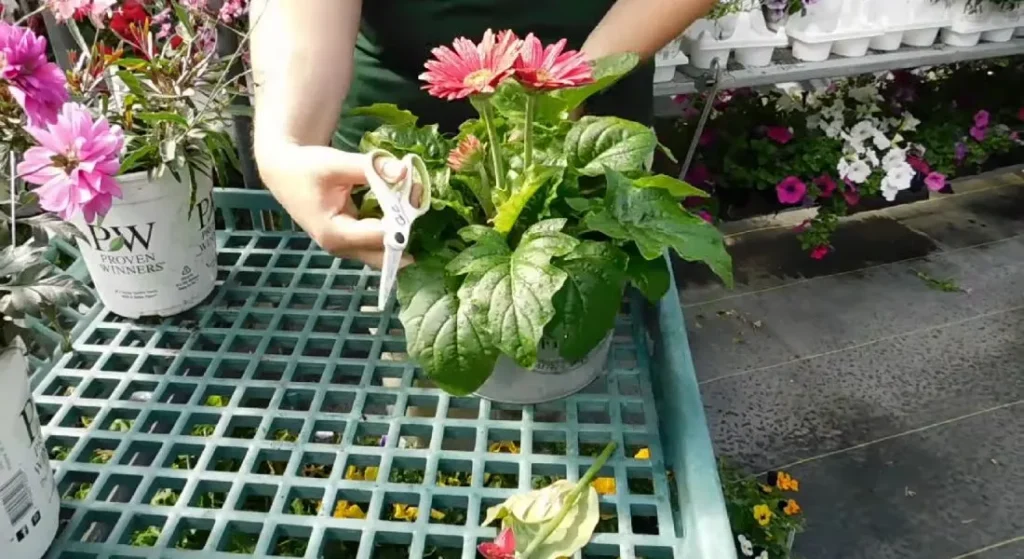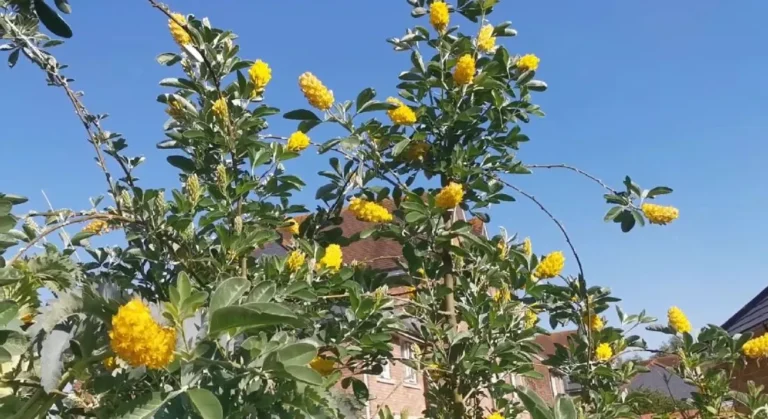Gerbera Daisy Leaf Problems: Common Causes and Solutions
Are you a proud owner of Gerbera daisies but struggling with leaf problems? Seeing your plant’s leaves turning yellow, brown, or developing spots can be disheartening.
But don’t worry, it’s a common issue that can be treated and prevented with the right knowledge and care. Keep reading to learn how to identify and solve these leaf problems, and keep your Gerbera daisies thriving.
Key Takeaways
- Gerbera daisy leaf problems are a common issue that can be treated and prevented with the right knowledge and care.
- Identifying the root cause of the problem is essential in treating and preventing leaf problems.
- Regular maintenance, such as proper watering and fertilizing, can help prevent future leaf problems.

Gerbera Daisy Leaf Problems
Gerbera daisies are beautiful and vibrant plants that can brighten up any space. However, they are not immune to leaf problems. If you notice any issues with your Gerbera daisy leaves, it’s essential to address them quickly to prevent further damage.
Here are some common Gerbera daisy leaf problems and how to remedy them:
Yellowing Leaves
Yellowing leaves are a sign that something is not right with your Gerbera daisy. The most common cause of yellowing leaves is overwatering. When the plant receives too much water, the roots cannot absorb oxygen, leading to root rot. This, in turn, causes the leaves to turn yellow.
If you notice yellowing leaves, reduce watering and remove any dead or rotting roots. Make sure the soil is well-draining and allow the top inch of soil to dry out before watering again.
Brown Spots
Brown spots on Gerbera daisy leaves can be caused by various factors, including fungal or bacterial diseases, insect infestations, or improper watering.
To remedy brown spots, remove any affected leaves and dispose of them. Treat the plant with a fungicide or insecticide, depending on the cause of the problem. Ensure proper watering practices and avoid getting water on the leaves.
Curling Leaves
Curling leaves are a sign of stress in Gerbera daisies. The most common cause of curling leaves is temperature stress, either from being too cold or too hot. Gerbera daisies prefer temperatures between 60-75°F.
If you notice curling leaves, ensure the plant is in an appropriate temperature range. Keep the plant away from drafts and direct sunlight. Ensure proper watering practices and consider using a humidifier to increase humidity levels.
Black Spots
Black spots on Gerbera daisy leaves are a sign of a fungal disease called leaf spot. This disease is caused by overwatering, poor air circulation, and high humidity levels.
To remedy black spots, remove any affected leaves and dispose of them. Treat the plant with a fungicide. Ensure proper watering practices, avoid getting water on the leaves, and increase air circulation around the plant.
Wrinkled Leaves
Wrinkled leaves are a sign of dehydration in Gerbera daisies. This can be caused by underwatering or improper watering practices.
To remedy wrinkled leaves, ensure the plant is receiving enough water. Water the plant thoroughly, ensuring the soil is evenly moist. Allow the top inch of soil to dry out before watering again.
Identifying Common Leaf Problems

Gerbera daisies are popular for their bright and cheerful blooms, but sometimes their leaves can develop problems that detract from their beauty. In this section, we’ll discuss some common leaf problems that you may encounter.
Fungal Diseases
Fungal diseases can cause a variety of symptoms on Gerbera daisy leaves, including spots, discoloration, and wilting. Here are some common fungal diseases to look out for:
- Powdery mildew: This fungal disease appears as a white or gray powdery coating on the leaves. It can cause the leaves to become distorted and eventually die. Powdery mildew thrives in humid conditions, so make sure to keep your plants well-ventilated and avoid overhead watering.
- Leaf spot: Leaf spot is caused by several different fungi and can appear as dark spots on the leaves. The spots may have a yellow halo around them and can cause the leaves to drop prematurely. To prevent leaf spot, make sure to water your plants at the base and avoid getting the leaves wet.
- Root rot: Root rot is caused by a fungus that attacks the roots of the plant, causing them to rot. This can lead to wilting and yellowing of the leaves. To prevent root rot, make sure your plants are in well-draining soil and avoid overwatering.
Pest Infestations
Several pests can infest Gerbera daisy leaves, causing damage and discoloration. Here are some common pests to look out for:
- Aphids: Aphids are small, pear-shaped insects that can appear in large numbers on the leaves. They suck the sap from the plant, causing the leaves to become distorted and yellowed. To control aphids, you can spray your plants with a mixture of water and dish soap or use insecticidal soap.
- Spider mites: Spider mites are tiny pests that can be difficult to see with the naked eye. They feed on the underside of the leaves, causing them to become stippled and discolored. To control spider mites, you can spray your plants with water or use insecticidal soap.
- Thrips: Thrips are small, slender insects that feed on the leaves and flowers of the plant. They can cause the leaves to become distorted and discolored. To control thrips, you can use sticky traps or insecticidal soap.
Nutrient Deficiencies
Nutrient deficiencies can cause the leaves of Gerbera daisies to become yellowed or discolored. Here are some common nutrient deficiencies to look out for:
- Nitrogen deficiency: Nitrogen deficiency can cause the leaves to become pale and yellowed. To remedy this, you can fertilize your plants with a nitrogen-rich fertilizer.
- Potassium deficiency: Potassium deficiency can cause the edges of the leaves to become yellowed or browned. To remedy this, you can fertilize your plants with a potassium-rich fertilizer.
- Iron deficiency: Iron deficiency can cause the leaves to become yellowed with green veins. To remedy this, you can fertilize your plants with an iron-rich fertilizer or add chelated iron to the soil.
By identifying and addressing these common leaf problems, you can help your Gerbera daisies stay healthy and beautiful.
Treatment and Prevention Methods
Gerbera daisies are beautiful and vibrant flowers that can brighten up any garden or home. However, they are susceptible to leaf problems that can affect their growth and appearance.
To ensure that your Gerbera daisies remain healthy and beautiful, it is essential to follow proper treatment and prevention methods.
Proper Watering Techniques
Overwatering or underwatering your Gerbera daisies can lead to leaf problems. It is crucial to water them correctly to prevent these issues. Here are some proper watering techniques to follow:
- Water your Gerbera daisies in the morning to allow the leaves to dry out during the day. Wet leaves can lead to fungal diseases.
- Water the soil around the plant, not the leaves.
- Ensure that the soil is well-draining to prevent root rot.
- Water your Gerbera daisies when the top inch of soil is dry to the touch.
Appropriate Fertilization
Gerbera daisies require proper fertilization to remain healthy and prevent leaf problems. Here are some appropriate fertilization techniques to follow:
- Use a balanced fertilizer with equal amounts of nitrogen, phosphorus, and potassium.
- Fertilize your Gerbera daisies every two to three weeks during the growing season.
- Avoid over-fertilization, as it can lead to salt buildup in the soil and damage the roots.
Effective Pest Control
Pests can also cause leaf problems in Gerbera daisies. Here are some effective pest control methods to follow:
- Inspect your Gerbera daisies regularly for signs of pests, such as spider mites, aphids, or whiteflies.
- Use insecticidal soap or neem oil to control pests.
- Remove any infected leaves or flowers to prevent the spread of pests.
By following these treatment and prevention methods, you can keep your Gerbera daisies healthy and beautiful. Remember to inspect your plants regularly and take action immediately if you notice any signs of leaf problems. With proper care, your Gerbera daisies will thrive and bring joy to your garden or home.
Regular Maintenance for Healthy Gerbera Daisies

If you want your Gerbera daisies to remain healthy and vibrant, you need to give them regular maintenance.
Here are some tips on how to keep your Gerbera daisies in top condition:
1. Watering: Gerbera daisies prefer medium moisture conditions. Water the plants when the soil begins to dry out, but don’t overwater them. Overwatering can lead to root or stem rot. Make sure the soil drains freely, and if it doesn’t, consider planting your daisies in containers or raised planting beds.
2. Fertilizing: Gerbera daisies need regular fertilization to stay healthy. Use a balanced fertilizer with equal amounts of nitrogen, phosphorus, and potassium. Apply the fertilizer every two weeks during the growing season.
3. Pruning: Prune your Gerbera daisies regularly to encourage new growth and prevent diseases. Remove any dead or yellowing leaves, and trim back any stems that are growing too long. Use clean, sharp pruning shears to avoid damaging the plant.
4. Pest control: Keep an eye out for pests like aphids, spider mites, and whiteflies, which can damage your Gerbera daisies. Use natural remedies like neem oil or garlic sprays, or more chemical-based solutions depending on the severity of the infestation.
5. Sunlight: Gerbera daisies need plenty of sunlight to thrive. Make sure your plants are getting at least six hours of direct sunlight each day. If you’re growing your daisies indoors, use grow lights to supplement natural light.
6. Soil: Gerbera daisies prefer average to rich soils. Use a high-quality potting mix that drains freely. If you’re planting your daisies in the ground, amend the soil with compost or other organic matter to improve drainage and fertility.
By following these simple tips, you can keep your Gerbera daisies healthy and beautiful all year round. Regular maintenance is key to preventing common leaf problems and diseases, so make sure you’re giving your plants the care they need.
Frequently Asked Questions (FAQs)
How to keep gerbera daisies blooming?
Gerbera daisies are known for their colorful blooms, but to keep them blooming for longer, you need to take proper care of them. Here are some tips to keep your gerbera daisies blooming:
- Water them regularly: Gerbera daisies like to be kept moist, but not wet. Water them deeply once a week, or more frequently in hot weather.
- Fertilize them: Use a balanced fertilizer every two weeks during the growing season to encourage healthy growth and blooming.
- Deadhead spent blooms: Remove spent blooms regularly to encourage new growth and blooming.
- Provide enough sunlight: Gerbera daisies need at least six hours of direct sunlight each day to bloom properly.
How to treat fungus on gerbera daisy?
Fungus can be a common problem for gerbera daisies, especially in humid conditions. Powdery mildew is a common fungal disease that affects gerbera daisies. Here are some tips to treat fungus on gerbera daisy:
- Remove affected leaves: If you notice any leaves with fungus, remove them immediately to prevent the spread of the disease.
- Use a fungicide: Apply a fungicide to the plant as per the instructions on the label. This will help to kill the fungus and prevent it from spreading.
- Improve air circulation: Good air circulation can help to prevent the spread of fungus. Make sure your plants are not crowded, and prune them regularly to improve air circulation.
What are common gerbera pests and diseases?
Gerbera daisies can be susceptible to a range of pests and diseases. Some common gerbera pests and diseases include:
- Aphids: These tiny insects can suck the sap from the plant and cause the leaves to curl and distort.
- Spider mites: These pests can cause yellowing of leaves and webbing on the plant.
- Powdery mildew: This fungal disease can cause a white powdery coating on leaves and flowers.
- Root rot: Overwatering can cause root rot, which can cause the plant to wilt and die.
Why are my gerbera daisy leaves turning brown?
Gerbera daisy leaves can turn brown for a range of reasons. Here are some common causes:
- Overwatering: Too much water can cause the roots to rot, which can lead to brown leaves.
- Underwatering: Not enough water can cause the leaves to dry out and turn brown.
- Fungus: Fungal diseases can cause brown spots on leaves.
- Pests: Some pests, such as spider mites, can cause brown leaves.
What is the green bud disease in gerberas?
Green bud disease is a fungal disease that affects the flower buds of gerberas. The disease causes the buds to turn green and fail to open. Here are some tips to prevent green bud disease in gerberas:
- Provide good air circulation: Good air circulation can help to prevent the spread of fungal diseases.
- Avoid overwatering: Overwatering can cause fungal diseases to develop.
- Remove affected buds: If you notice any buds with green bud disease, remove them immediately to prevent the spread of the disease.
How do I get rid of aphids on my gerbera daisies?
Aphids can be a common problem for gerbera daisies. Here are some tips to get rid of aphids:
- Spray with water: A strong jet of water can help to dislodge aphids from the plant.
- Use insecticidal soap: Apply insecticidal soap to the plant as per the instructions on the label. This will help to kill the aphids.
- Use neem oil: Apply neem oil to the plant as per the instructions on the label. This will help to repel aphids and other pests.
Conclusion
In conclusion, Gerbera daisy leaf problems can be a real headache for plant owners. However, with proper care and attention, most issues can be resolved before they become too serious. Here are some key takeaways to keep in mind:
- Regularly inspect your plants for signs of discoloration, damage, or pests. Early detection is key to preventing larger problems.
- Ensure that your plants are receiving the proper amount of light, water, and nutrients. Gerbera daisies prefer bright, indirect light and well-draining soil.
- Avoid overwatering your plants, as this can lead to root rot and other issues. Water only when the top inch of soil feels dry to the touch.
- If you notice powdery mildew or other fungal diseases, try using a fungicide or neem oil to treat the problem. Be sure to follow the instructions carefully and wear protective gear.
- If your plants are falling over, they may need additional support. Try staking them or using a trellis to keep them upright.
Remember, the key to keeping your Gerbera daisies healthy and vibrant is to give them the care and attention they need. With a little bit of effort, you can enjoy beautiful blooms all season long.
Related Posts:






